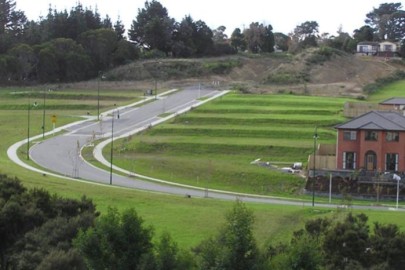
Terracing and land contouring creates flat, geotechnically stable land for establishing roads and concrete foundations
The team is collaborating with engineering colleagues at AECOM, who will undertake modelling to better define the risk of flooding in various storm events, and with Koru Environmental to investigate policy responses. The research, co-funded by Auckland Council, is the only urban project in a Ministry for Environment portfolio investigating nature-based solutions. It is hoped learnings can be shared with other regions.
Lead researcher Dr Robyn Simcock says soil is often compacted during urban development, slowing the rate at which water moves into and through soil. “Sometimes less rain can enter the soil, but compaction can also mean soils lose much of their ‘sponginess’ especially when topsoil depths are reduced,” she says. Two sub-catchments in Auckland, Mangere and Te Auaunga (Oakley Creek), have been chosen for the study.
“The sub-catchments meet most or all our technical criteria. They have natural soils in public open spaces that range from well-drained to poorly drained and have extensive development sites. Having recent development sites is important so that we can quantify the impacts of modern construction practices,” says Robyn.
The research team will be hand-excavating pits to measure how fast water moves into and through the soil and to identify soil horizons with limited water and root movement. Intact soil cores will be taken back to the Hamilton soil physics laboratory to test soil density and moisture storage capacity.
The project includes modelling potential solutions such as soil loosening to increase the rate water enters soil, increasing topsoil depth and increase profile water storage (for example, by building with piles to retain soil depth). Options will be explored through engaging with industry and iwi/hapū, led by Koru Environmental and Auckland Council respectively. Robyn says the project also aims to identify hot spots within the chosen sub-catchments where maintaining or improving permeability is likely to have the greatest benefit.
“By early 2025 the project team plans to have a draft technical guidance document for regional councils, the construction industry, and individual property owners providing potential methods to improve soil sponginess and thus improve our resilience to a changing climate,” says Robyn.

